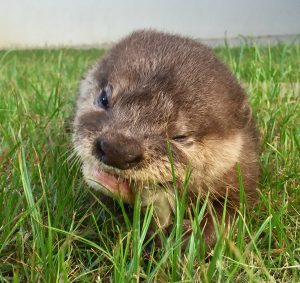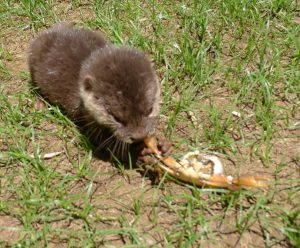I was visited by my pamangkins from Manila this past summer break. They are fishing fanatics so I decided to take them to the Iwahig Penal Colony because it has several picnic grounds beside the Iwahig River, and the river is full of papait or paitan, a sardine sized fish that always takes the bait.
BY ANY OTHER NAME
Upon arrival and unloading our stuff, we noticed two curious looking creatures tailing one of the inmates. I first thought that they were big rats. Upon closer examination, I recognized them as what I call “Palawan River Otters.” These are very shy creatures and I was extremely surprised to find them so near the city proper. As otters are shy and elusive, we locals hardly ever see these creatures. In fact, one would not know that otters are in an area unless the person is already familiar with this creature through a previous encounter, and can discern their path markings or see or smell their spraints (otter poop) along the riverbank.
Sightings are extremely rare that only people who live or work along riverbanks with existing otter colonies are aware of this creature. I did a little experiment and showed pictures of the otters to my staff and some guests. Out of the dozens who saw the pictures, just one recognized the animals, and only this one person knew the Filipino term for otter: “dungon.”
I then wondered if the term “Palawan River Otter” was correct. A quick Google search for it did not yield any results. I found that the internationally accepted name of the dungon is “Asian Short-Clawed Otter” and the scientific name is Aonyx cinerea. Other accepted variations are Oriental Short-Clawed Otter, Asian Small-Clawed Otter, and Oriental Small-Clawed Otter.
Our otters are river dwelling otters, unlike the bigger sea otters of North America. The name is also fitting because, while they also exist in other Asian countries, in the Philippines, they are only found in Palawan—just like many other animals I have written about previously. They have the aforementioned short claws in comparison to its cousins in the Americas. Other popular otter species are the sea otter of North America and the giant otter of South America. We saw the former in the animated film “Finding Dory,” while the latter is often featured in National Geographic documentaries as they are dwellers of the mighty Amazon River.
DIFFERENT FEET
The uniqueness of our dungon is centered mostly on its paws. Aside from having shorter claws, they also have partially webbed feet. The other two species of otters I mentioned have fully webbed feet such that, when only the feet are visible, one cannot be sure if the object in view is an aquatic bird’s foot or the tail of a small seal.
The difference in paw structure of these otters results in different hunting tactics and behavior. The dungon has enhanced dexterity and tactility due to its shorter claws and lesser webbing. Their paws differ greatly from their cousins’ such that theirs look almost like primate hands. It is no wonder that they hunt by feeling with their paws in the underwater mud for prey, or chase, pounce, and grab with their hand-like paws above water. They can easily pounce on and catch small crabs regardless if it is above or under the water. They are even said to savor the slippery and elusive mudskipper.
DON’T BE FOOLED
With all this talk of cuteness and cuddliness, we must be reminded that these animals are smart and can be ferocious when they feel threatened. I was quite taken aback when one of the baby dungon suddenly hissed threateningly with its baby fangs bared at an approaching dog, which was just being friendly. I was lost in adoring the creatures for their cuteness, so it never occurred to me that they could be ready for a brawl when necessary.
Those particular otters were just over a month old and their teeth were just beginning to grow out of the gums. But they sure knew how to take a defensive stance, and the tiny teeth were needle sharp. One of them tried to suck on my thumb, probably thinking my thumb is part of a milk bottle.
With my experience raising newborn musang to adulthood, I can surely say that dungon teeth are much much sharper. I guess this is a no-brainer. The musang are fruit eaters while the dungon are definitely carnivores. So far, these two dungon are still fed with milk and crustaceans alternately. Fortunately, suahe (a type of shrimp) and dawat (small crabs) are affordable here in Palawan. Otherwise, it will take a huge budget to keep their tummies full.
THAT SMELL
Unlike the musky musang, these guys smell fishy—literally. They smell like daing (dried milkfish) when clean and like a palengke (wet market) when dirty. Their spraint looks like a half-digested goo of fish and smells just like it. The smell is not too bad at first, but it gets ugly really fast in this warm climate of ours.
Given an ample source of water, they do like to keep themselves clean though, always rolling in the grass and “swimming” on the ground.
During a recent trip to Sabang, as I knew that Sabang and the surrounding areas are protected wildlife and forest sanctuaries, I asked around about the dungon, and sure enough, the locals confirmed that there were dungon upriver, in densely forested areas where the water is no longer murky and salty. They also confirmed what I knew about these creatures.
They are social animals, and a group is composed of extended family members. Each group resides in an area that they have established as their territory. They are said to mate for life, and the death of the leading pair can cause the group to break up or compel members to join other groups. They live along the riverbank in burrowed dens that they either dig themselves, or which naturally exist, or which they have taken over from another animal.
As with other social animals, they come out to hunt and play as a group. The adults warily watch over the group as they feed and the youngsters have fun. The young adults also help out in taking care of the young. I think this behavior is true for many group animals, such as the African wild dog and particularly the meerkat. The dungon are said to be most active during the day. However, there are observations that they do hunt at night.
Personally, I believe that our local dungon are daylight creatures, due to their reliance on their sight to spot their favorite prey, and also due to the fact that they have to chase their food. I have reason to believe that they may be getting more active at night due to human interference. The local practice of using electrocution to catch fish disturbs the reproduction cycle of fish and crustaceans. This—not to mention overfishing and pollution—affects the availability of dungon prey. Knowing them as shy creatures, our presence may also be causing them to “reschedule” their activities.
There are stories from old people of the days of dungon “armies,” when they would confidently hiss and challenge approaching banca by the dozen. An old acquaintance told me that while a dungon can be a loyal pet similar to a dog, people rarely dare to venture into their territory to capture young otters. He said that trappers told him tales of a hundred dungon defending their young against men.
I am not sure how accurate his representation of the group size is, but I think I understand why men, prior to the computer age, gave the dungon a high level of respect. Maybe it is also for this reason that, despite their abundance during my early years, I was not able to see much of them. How I wish the same can still be said now about the dungon armies. But with the availability of traps and guns, and with their habitat broken into tiny scattered wetlands between farms, I don’t think the otters stand a chance against men.
This appeared in Animal Scene magazine’s October 2017 issue.
Read more about Alvin Lao’s Palawan adventures here: https://animalscene.mb.com.ph/2018/04/20/meeting-the-palawan-bearcat/







